- About
- Academics
-
Undergraduate Programs
- Civil and Environmental Engineering
- Architecture and Architectural Engineering
- Mechanical Engineering
- Industrial Engineering
- Energy Resources Engineering
- Nuclear Engineering
- Materials Science and Engineering
- Electrical and Computer Engineering
- Naval Architecture and Ocean Engineering
- Computer Science and Engineering
- Aerospace Engineering
- Chemical and Biological Engineering
-
Graduate Programs
- Civil and Environmental Engineering
- Architecture and Architectural Engineering
- Mechanical Engineering
- Industrial Engineering
- Energy Systems Engineering
- Materials Science and Engineering
- Electrical and Computer Engineering
- Naval Architecture and Ocean Engineering
- Computer Science and Engineering
- Chemical and Biological Engineering
- Aerospace Engineering
- Interdisciplinary Program in Technology, Management, Economics and Policy
- Interdisciplinary Program in Urban Design
- Interdisciplinary Program in Bioengineering
- Interdisciplinary Program in Artificial Intelligence
- Interdisciplinary Program in Intelligent Space and Aerospace Systems
- Chemical Convergence for Energy and Environment Major
- Multiscale Mechanics Design Major
- Hybrid Materials Major
- Double Major Program
- Open Programs
-
Undergraduate Programs
- Research
- Campus Life
- Communication
- Prospective Students
- International Office
News
SNU College of Engineering Successfully Hosts the 1st ‘Robotics Day,’ Showcasing Latest Robotic Research Achievements
-
Uploaded by
대외협력실
-
Upload Date
2024.12.03
-
Views
493
SNU College of Engineering Successfully Hosts the 1st ‘Robotics Day,’ Showcasing Latest Robotic Research Achievements
Demonstrations from 25 robotics labs at SNU and student team robotics competition
Seoul National University College of Engineering announced that it successfully held the first 'SNU Robotics Day' on November 29 at the Engineering Hall on the Gwanak Campus.
Held as part of SNU's engineering innovation program 'Keep Watch' that supports interdisciplinary research, 'Robotics Day' was designed to showcase the achievements of interdisciplinary research in the field of robotics. The event was divided into two parts: the first part, where engineers who build, research, and utilize robots at Seoul National University introduced their labs and presented research achievements and robot demonstrations in robotics (all scientific elements required to design and operate robots), and the second part, where 60 students from the Creative Engineering Design class competed in the final round of the 'Robocon' with robots they built themselves.
“When researching future core technologies such as robots, researchers must first identify and share what our society needs and what are the biggest issues in society,” said Young-oh Kim, dean of the College of Engineering, emphasizing the purpose of the event by saying, ”We held Robotics Day for the first time to bring roboticists together to find the direction of technological innovation in response.”
In the first part of the event, which began with congratulatory remarks from Byoung-Tak Zhang, head of the AI Research Center at Seoul National University, and Chongwoo Park, former president of the Robotics Society, 25 research teams at Seoul National University explained the principles behind the robots they have recently published or are developing. A large robot, a swimming robot, a surgical robot, and a space robot, which were introduced via video because they were difficult to demonstrate on site, attracted the attention of the attendees.
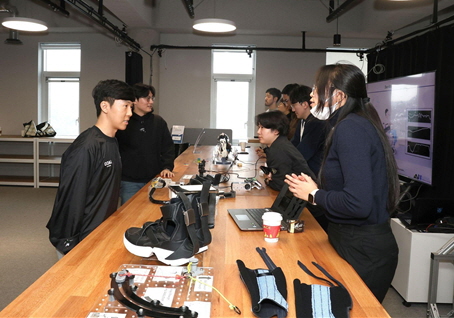
▲ Various wearable robots showcased at Robotics Day
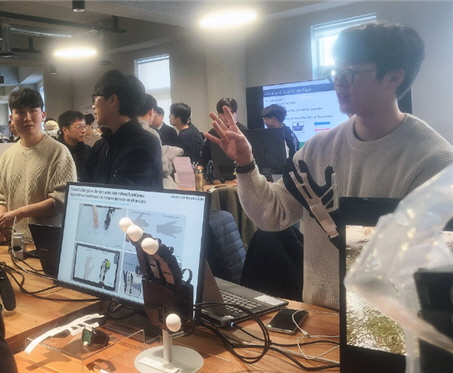
▲ Hand motion sensing glove. The robot moves as the gloved hand moves.
At the AI Robot Cluster in Haedong Advanced Engineering Center, a newly opened AI education and research space, more than 40 researchers demonstrated robots. In particular, attendees were introduced to a 'humanoid robot' that acts as a guide at the entrance and grabs a person's hand with a sensor, and a 'wearable robot' that can be worn by a person for the first time. The “exo-unloader robot,” which is lightweight and reduces the load on the knees while being made of special fabric, the “squat robot,” which is a vest-like device that supports the back when lifting heavy objects, the “waist motion support wearable suit,” which reduces the load on the spine when working with heavy objects, and the “hip assist robot,” which improves the ability to walk and run by moving the hip joint of a person. “Wearable robots all have the same purpose in terms of protecting the human body and enhancing physical performance, but their approaches vary widely, from materials to programs,” explained one of the researchers who demonstrated them.
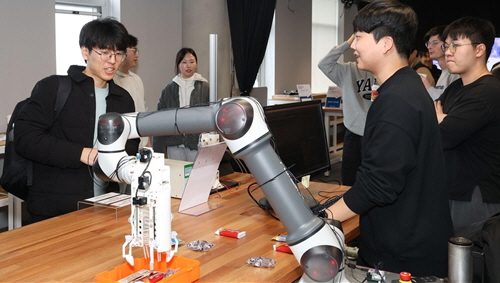
▲ Mogrip robotic arm. It is the first to apply the principle of grasping by human fingers and placing it on the palm of the hand.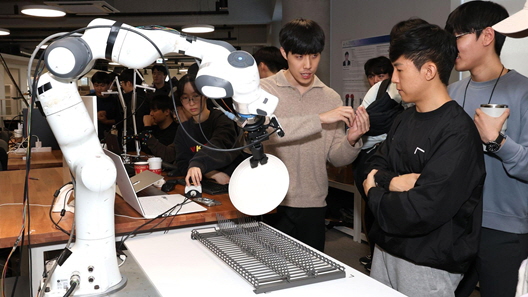
▲ Dish storage robot. Stacking plates one after another may seem like a simple labor, but it is a challenging task that requires a high level of visual intelligence to be programmed into the robot arm.
Also of interest to attendees were robots that closely mimic functions that could previously only be performed by the human hand. Demonstrations of the “Mogrip Robot,” which is the first robot to realize the principle of movement that humans use to pick up objects with their fingers and transfer them to a wide palm, and the “Dish Storage Robot Arm,” which organizes plates in a narrow space, demonstrated the superior technology of the SNU research team. “These robots are the successful outcome of numerous challenges, as robots need to have excellent visual intelligence and judgment to perform labor that seems simple to humans,” said a researcher involved in the development. 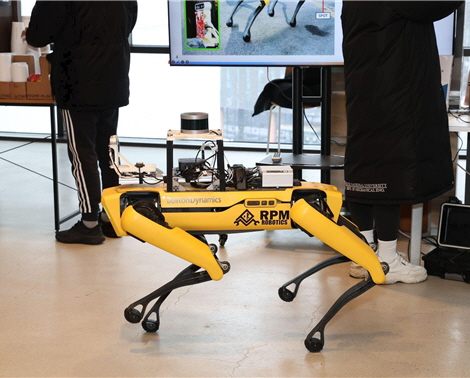
▲ Robot dog. The spatial intelligence AI created by the SNU research team was attached to the existing model, allowing it to move freely.
Other robots of interest included medical robots, including a “haptic surgical robot” that measures the tactile sensation of patient tissue during surgery and relays tactile information to the surgeon's hands as if they were operating by hand, and a robotic dog that the researchers installed their own spatial awareness AI program on a model developed by Boston Dynamics, a U.S. robotics company, to enable it to navigate freely in new, untrained spaces. “It was a great time to see the enthusiasm of young researchers through the presentations and demonstrations,” said Dr. Yoonseok Pyo of a robotics company, who watched dozens of robots being demonstrated. ”There are many robots that I would like to try to commercialize immediately, and I feel the need to actively collaborate with Seoul National University.”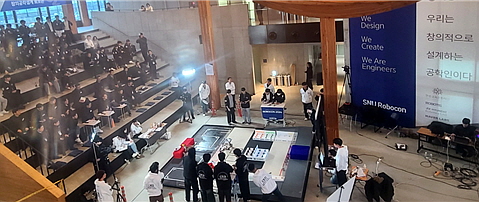
▲ The final round of the Roboton at Robotics Day Part 2
The second part of the event was the 'Robocon', where 60 first-year students, who are taking the basic robotics course 'Creative Engineering Design' and dream of becoming future robotics engineers, competed in a team competition with their own robots. The Robotics Day ended with congratulations for the 'Assembly King' team, which creatively utilized the multi-degree-of-freedom robot arm, which was newly introduced this year, winning the competition and earning the right to participate in the international Robocon.
After the event, Professor Chongwoo Park of the Department of Mechanical Engineering at Seoul National University, who served as the 24th president of the IEEE RAS (Robotics and Automation Society, an affiliate of the Institute of Electrical and Electronics Engineers), a representative international society in the field of robotics, said, “The age of robots is not a time when machines with human appearance are sold, but a time when we can solve the problems we need to solve by creating machines with intelligence, and this is the age of robots.” “There are still many problems on the planet that can only be solved through robotization. We hope that Robotics Day, which will be held every fall from now on, will inspire engineers to take on the challenges of our time.”
[Contact Information]
Kyujin Cho, Professor, Department of Mechanical Engineering, Seoul National University / +82-2-880-1703 / kjcho@snu.ac.kr